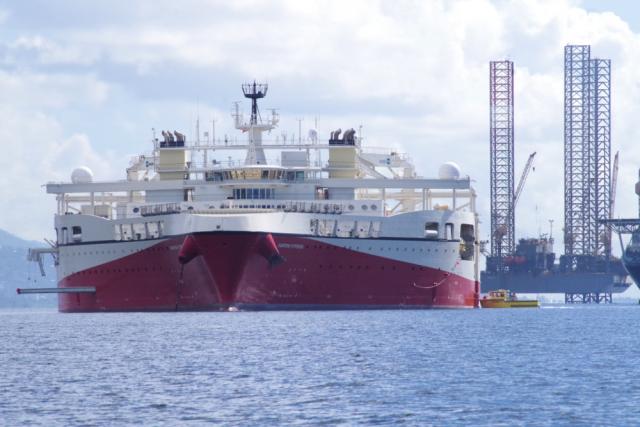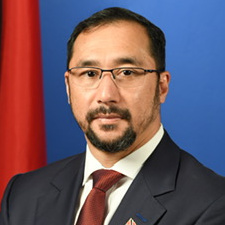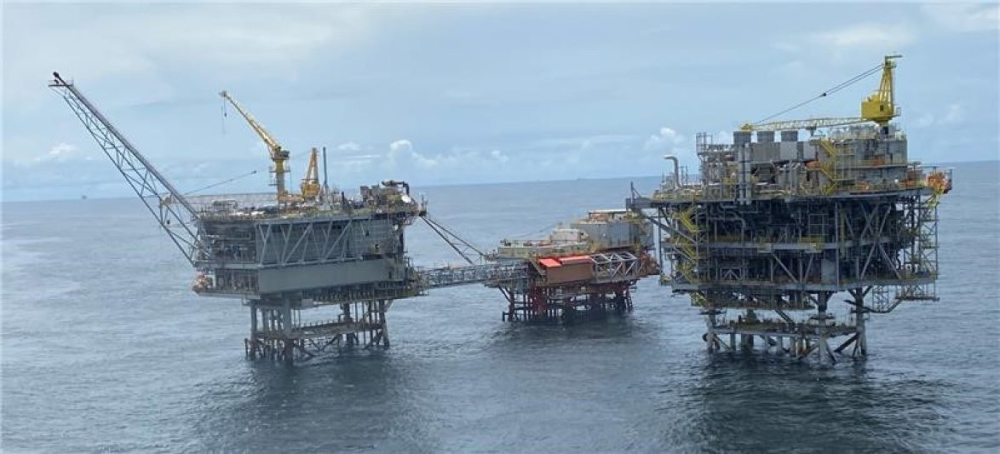
Trinidad’s gas production will get a lift in the second half of the year from developments to come online including De Novo’s Zandolie project, EOG Resources’ Osprey East and West project, and bpTT’s Cassia Compression project among others. Pictured is a high-capacity seismic vessel owned by PGS in the Port of Spain, Trinidad. (Source: Chris worldwide / Shutterstock.com)
Caribbean producer Trinidad and Tobago looks to boast double-digit production growth by 2024 for both natural gas and crude oil as numerous developments come on stream. However, gains on the gas side, which are crucial to the twin-island nation’s gas-dependent economy, will still fall short of highs seen in 2010.
At the moment, Trinidad continues to suffer from a scarcity of gas caused in part due to unattractive fiscal terms as well as other headwinds confronting the spending habits of international oil companies active in the country. The lack of gas has negatively impacted the country’s gas-dependent industries from LNG to ammonia and methanol with numerous plant closures revealed in recent years.
“Gas and oil will remain the core elements of the domestic energy mix for the foreseeable future.”—Stuart Richard Young, Minister of Energy and Energy Industries, Trinidad and Tobago
Trinidad already exports LNG, ammonia and methanol to Europe, Asia and other countries and is riding the wave of higher commodity prices. Higher gas production could spur an increase in exports to these markets, among others it already serves. Trinidad is home to one of only two LNG exporting facilities in Latin America, the other being in Peru, which now competes with the U.S. for LNG market share.
However, Trinidad has struggled to boost gas production in recent years and any production gains will do little to calm supply fears in the LNG market. Higher LNG exports aren’t likely to flow yet from Trinidad until a decision is taken regarding the restructuring of its 15 million ton per year four-train Atlantic LNG complex which is operating with just three trains due to a lack of gas and disagreements between Shell Plc and BP Plc, key partners in the project.
Trinidad’s gas production is expected to reach 3.28 Bcf/d by 2024, up 14% over 2.88 Bcf/d produced in January 2022, the last month data was published by the country’s Ministry of Energy and Energy Industries (MEEI). Gas production last peaked in February 2010 at 4.52 Bcf/d while in the same year it averaged 4.33 Bcf/d.
In the second half of 2022, gas production will get a lift from developments to come online including De Novo Energy Ltd.’s Zandolie project, EOG Resources Inc.’s Osprey East and West project, and bp Trinidad and Tobago LLC’s (bpTT) Cassia Compression project among others onshore.

Beyond 2024, “there is a suite of projects that are awaiting sanction and are critical to meeting the requirements for power generation, downstream and LNG,” MEEI head Stuart Young said June 1 during his keynote speech at the Trinidad and Tobago Energy Conference in Port of Spain.
By 2027, two promising projects with potential to drastically impact gas production could commence, Young said. Production from the projects could effectively push Trinidad’s gas volumes above the 4 Bcf/d mark, which has been elusive for some time.
The first is the Manatee field development led by Shell, and the second is the Calypso deepwater project led by BHP, Woodside and bpTT. Manatee production is expected to come online in 2027 at around 700 MMcf/d. The deepwater gas resources from Calypso are being appraised but estimated at approximately 6 Tcf with production potential between 600 MMcf/d and 1 Bcf/d, according to Young.
On the oil side production is expected to reach 85,000 bbl/d by 2024, up over 40% from around 60,000 bbl/d currently. Similar to gas production, Trinidad’s oil production peaked in February of 2010at 73,845 bbl/d. By 2026, oil production could reach 104,000 bbl/d, the minister said owing to numerous developments mainly onshore.
“Gas and oil will remain the core elements of the domestic energy mix for the foreseeable future,” Young said. “The sustainability of the domestic energy industry will be driven by not only upstream investments but the reduction of carbon dioxide and greenhouse gases.”
Bid Rounds
Trinidad aims to continue moving forward with its deepwater, onshore and shallow-water bid rounds to attract investors as part of plans to boost oil and gas reserves and production to continue to supply the demands of the internal market whether for end products for domestic consumption or export.
“Government recognizes that to encourage further investment in the upstream that the fiscal regime needs to be updated,” Young said, adding that the ministry is reviewing the regime “to ensure this country’s competitiveness, with emphasis on three main petroleum taxes, namely petroleum profits tax, supplemental petroleum tax and royalty.”
The deepwater bid round, which was launched in late 2021, officially closes on June 2. The round offered a large selection of deepwater acreage comprising 17 blocks, and “there have been changes to some of the terms and conditions of the Model Production Sharing Contract which will govern these blocks,” Young said.
The onshore bid-round will be launched in coming weeks with blocks currently being proposed including Aripero, Buenos Ayres, Charuma, Cipero, Cory D, Cory F, Guayaguayare, South West Peninsula Offshore, South West Peninsula Offshore, St. Mary’s and Tulsa. The virtual data room related to the onshore bid round is expected to go live soon to showcase seismic, well data and more details on the blocks.
Trinidad also plans to launch its offshore shallow-water bid round after the onshore round. The government is in the preliminary block evaluation stage but anticipates 25 open shallow-water blocks will be up for consideration. 13 of the blocks are in the Columbus Basin while 12 blocks are in the North Coast Marine Area, the South Coast Marine Area and the Gulf of Paria.
Recommended Reading
Santos’ Pikka Phase 1 in Alaska to Deliver First Oil by 2026
2024-04-18 - Australia's Santos expects first oil to flow from the 80,000 bbl/d Pikka Phase 1 project in Alaska by 2026, diversifying Santos' portfolio and reducing geographic concentration risk.
Iraq to Seek Bids for Oil, Gas Contracts April 27
2024-04-18 - Iraq will auction 30 new oil and gas projects in two licensing rounds distributed across the country.
Vår Energi Hits Oil with Ringhorne North
2024-04-17 - Vår Energi’s North Sea discovery de-risks drilling prospects in the area and could be tied back to Balder area infrastructure.
Tethys Oil Releases March Production Results
2024-04-17 - Tethys Oil said the official selling price of its Oman Export Blend oil was $78.75/bbl.
Exxon Mobil Guyana Awards Two Contracts for its Whiptail Project
2024-04-16 - Exxon Mobil Guyana awarded Strohm and TechnipFMC with contracts for its Whiptail Project located offshore in Guyana’s Stabroek Block.





